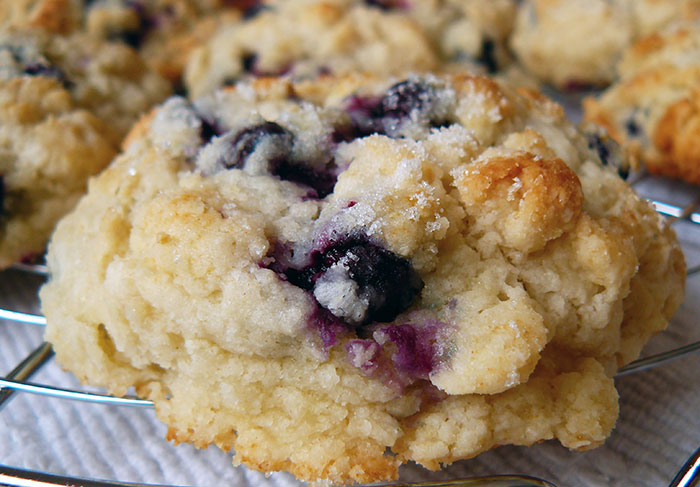
Sablage-method Blueberry Scones
| Ingredient | 12-14 Scones | 12-14 Scones |
|---|---|---|
| all-purpose flour | 3½ cups | 470g |
| baking powder | 1 Tbsp. | 1 Tbsp. |
| baking soda | ½ tsp. | ½ tsp. |
| salt | ½ tsp. | ½ tsp. |
| sugar | ¾ cup + extra to dust | ¾ cup + extra to dust |
| butter | 1 cup | 1 cup |
| fresh or frozen blueberries | 1 - 1½ cups | 1 - 1½ cups |
| heavy cream | ½ cup | ½ cup |
| buttermilk | ¾ cup | ¾ cup |
These blueberry scones are similar to regular scones, but use the sablage ("sandy") method of mixing in the butter, which produces an even more cake-like texture.
Preparation
- Sift together the flour, baking powder, baking soda, and salt into a large bowl. Put the bowl into the refrigerator to chill.
- Cut cold butter into 1cm (half-inch) cubes or slices.
- Preheat oven to 190°C (375°F).
Directions
- Mix the butter and dry ingredients using the sablage method.
Take the chilled bowl of dry ingredients and drop in the butter chunks, then cut in with a pastry cutter. When the chunks of butter are about pea sized, begin to mix using the sablage method: Scoop up some of the mixture in one hand and rub your other hand across it; the dough should crumble into a parmesan cheese-like texture. Continue until all the dough is evenly-textured; rub any larger chunks of butter between your fingertips to break them up. - Add blueberries.
Add the blueberries (do not thaw if using frozen ones) and toss together gently with a wooden spoon. - Mix in sugar, cream, and buttermilk.
Make a well in the center of the mixture and pour the sugar into it. Pour the cream and buttermilk onto the sugar, stir the well a bit to get the sugar to absorb the liquid, then mix it with the rest of the dough. Be careful not to overmix, or the scones will be tough. - Separate dough into balls.
Gently shape the dough into balls 5cm (2") in diameter; they should have a lumpy texture. Place the balls on a baking sheet 5cm (2") or so apart; use a sheet of parchment paper if you think the scones will stick to your pan. - Dust with sugar and chill.
Sprinkle some sugar on top, then put the balls in the refrigerator to chill for a bit; this will keep the scones from flattening out as they bake. - Bake.
Bake on the center rack for 25 to 30 minutes, or until golden brown. Cool on a wire rack.
Notes
- If you want to use a food processor instead of a pastry cutter, make the following changes:
- Put the cubed butter in the freezer until hard.
- Put the frozen butter and some of the flour mixture in the food processor; process for a few seconds at a time until the chunks are relatively small, being careful not to overprocess it into dough.
- Put the lumpy butter mixture in a large bowl and add the remaining flour mixture, then continue with the sablage process.
- The reason the sugar isn’t added until later is because it will draw the moisture out of the butter, which in turn sticks to the flour and will cause the dough to be more glutenous.
